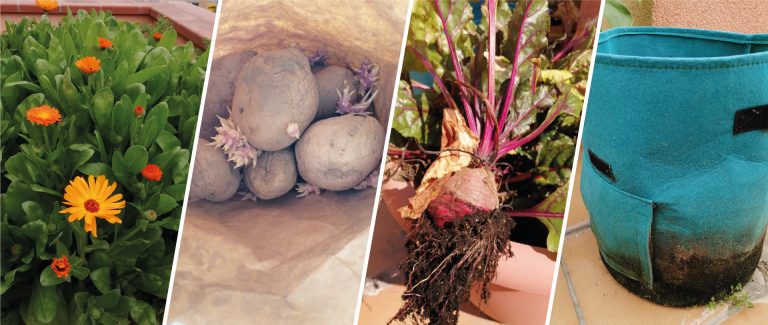
My terrace is home to a small garden, a green oasis in the city of Barcelona. It is basically a small-scale ecosystem of pots with a variety of plants that attract birds and insects. It has its own microclimate that sometimes it works against you. Temperatures will soar in the middle of July and August and that will pretty much make life a struggle for most of these plants.
The number of vegetables we sow are certainly not enough to feed us all at home, although I am proud to have harvested potatoes, beetroots, peppers, tomatoes, and various aromatic herbs. Unquestionably, we have the most wonderful lavender from the terraces and balconies of Barcelona. Its lilac flowers are a perennial attraction for thirsty insects that stop by to drink its nectar.
The latest addition to the garden is the marigold. During a visit to an urban garden in the city, I had the opportunity to collect a few seeds. I planted them and was surprised by the generosity with which they grew. The first photo at the top shows its first bloom, the orange colour of the petals and the green of the leaves describe the striking intensity with which they flourished. If you ever decide to plant marigolds, let the petals dry and fall. Behind them lies the magic of nature, there, dozens and dozens of seeds are patiently waiting to be collected and stored. This autumn, the seeds were potted in soil and bloomed again. I didn’t know it, but marigolds can also flower in milder winters.
Now wait for this, what would you say about growing potatoes on your balcony or patio? Or beets? It’s not difficult. The key ingredients are lots of patience with a pinch of consciousness of what you are creating. The essential elements are soil, sun, and water. For potatoes, I always use those that have sprouted in the kitchen. I leave them inside a cupboard to finish sprouting and then plant them. For beets, I usually grow them from seed. From your pantry, you can also use seeds from pumpkins or peppers; I highly recommend saving those seeds from organically grown vegetables. You need to dry them well before storing. If you have too many seeds or cuttings, look for someone to give or exchange them with; there is surely someone in your village or neighbourhood who doesn’t know how to start. Once you grown your green fingers, you can’t stop. Every year I look for a different challenge.
The photos at the top show the sprouted potatoes ready to be planted and the harvested beets. The green basket is the recipient where I plant potatoes because they need a bit more depth.
As summers are especially dry where I leave, it’s important to find some efficient way to water the plants. We use eco-friendly and biodegradable washing up liquid which allow us to collect the water for either flushing the toilet or watering the plants.
Once the fear of looking after your plants wears off, this is a very rewarding way to connect with them daily. They gift you with their fragrances, colours, and fruits, and spare nothing at all.
Whether you are an expert gardener or not, hope this post makes you feel that you need yet another plant in your life. Please tell me all about it!